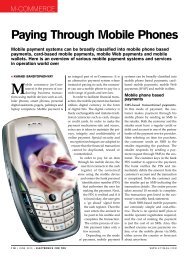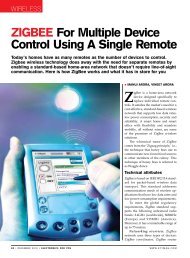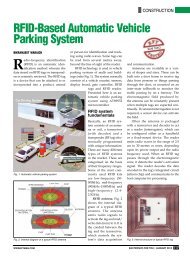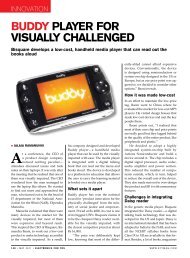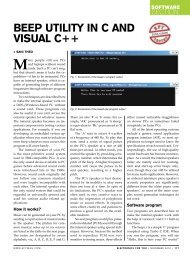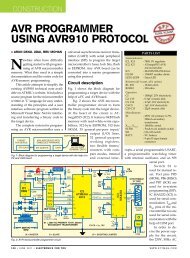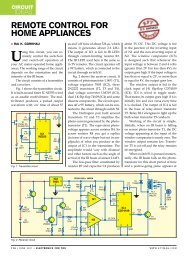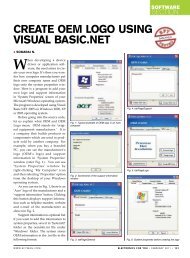How to EncodE and dEcodE InformatIon
How to EncodE and dEcodE InformatIon
How to EncodE and dEcodE InformatIon
You also want an ePaper? Increase the reach of your titles
YUMPU automatically turns print PDFs into web optimized ePapers that Google loves.
IT Zone<br />
sequential, whereas the 2421 <strong>and</strong> 5211<br />
codes are not sequential.<br />
Some features of<br />
weighted codes<br />
Except 8421 <strong>and</strong> 74-2-1 codes, for all<br />
other weighted codes some of the decimal<br />
number may be coded in more than<br />
one forms. For example, decimal 4 in<br />
2421 code may be represented as 1010<br />
or 0100. That’s why 2421 <strong>and</strong> 4221 are<br />
known as self-complementing codes.<br />
A property known as self-complementing<br />
is applied <strong>to</strong> select a code<br />
out of different options. The property<br />
is stated as follows: If ‘D’ is the given<br />
decimal number, you may code it in<br />
any option, but then decimal number<br />
9-D must be coded taking the option<br />
such that the code is bit-wise complement<br />
of the code of D. For example, if<br />
decimal 4 in 2421 is coded as 0100, then<br />
9-4=5 must be coded as 1011. See that<br />
1011 is bit-wise complement of 0100.<br />
We have shown the code in Table<br />
II applying the self-complementing<br />
property. A necessary condition of<br />
self-complementing property is that<br />
the sum of weights in the code is 9.<br />
The codes 8421 <strong>and</strong> 74-2-1 are not selfcomplementing.<br />
Non-weighted code<br />
In many cases, there may be some<br />
requirement for non-weighted codes<br />
(see Table III), particularly from design<br />
point of view. Non-weighted codes are<br />
codes that are not positionally weighted.<br />
That is, each position within the<br />
binary number is not assigned a fixed<br />
value. The examples of a few nonweighted<br />
codes are excess-3 code, 1-<strong>to</strong>-<br />
2 code <strong>and</strong> BCDP (BCD with parity).<br />
Excess-3 is a non-weighted code<br />
used <strong>to</strong> express decimal numbers. The<br />
code derives its name from the fact that<br />
each binary code is the corresponding<br />
8421 code plus 0011(3).<br />
Some features of nonweighted<br />
code<br />
Excess-3 code is just BCD with plus 3<br />
weight. If ‘d’ is the decimal number,<br />
d+3 is coded in 8421 <strong>to</strong> get the excess-3<br />
code. This code is the most important<br />
non-weighted code in digital logic design.<br />
1-<strong>to</strong>-2 code has a unique feature.<br />
No code has less than one <strong>and</strong> greater<br />
than two 1’s. BCDP (with odd parity) is<br />
designed so as <strong>to</strong> make any code having<br />
odd numbers of 1’s. This is done<br />
with selection of parity bit, which is the<br />
right-most bit of the code.<br />
Gray code/binary<br />
reflected code<br />
Table II<br />
Weighted Codes<br />
Decimal digit<br />
2421 code 74-2-1 code 4221 code<br />
Weight 2 4 2 1 Weight 7 4 -2 -1 Weight 4 2 2 1<br />
0 0 0 0 0 0 0 0 0 0 0 0 0<br />
1 0 0 0 1 0 1 1 1 0 0 0 1<br />
2 0 0 1 0 0 1 1 0 0 0 1 0<br />
3 0 0 1 1 0 1 0 1 0 0 1 1<br />
4 0 1 0 0 0 1 0 0 0 1 1 0<br />
5 1 0 1 1 1 0 1 0 1 0 0 1<br />
6 1 1 0 0 1 0 0 1 1 1 0 0<br />
7 1 1 0 1 1 0 0 0 1 1 0 1<br />
8 1 1 1 0 1 1 1 1 1 1 1 0<br />
9 1 1 1 1 1 1 1 0 1 1 1 1<br />
Decimal digit<br />
Table III<br />
Non-weighted Codes<br />
Excess-3 code<br />
(XS-3 code)<br />
1-<strong>to</strong>-2 code<br />
Gray code is a very important nonweighted<br />
code. An N-bit gray code is<br />
a sequence of all the N-bit binary numbers,<br />
ordered in such a way that each<br />
binary number differs from its predecessor<br />
<strong>and</strong> successor by exactly 1 bit<br />
(<strong>and</strong> the first <strong>and</strong> last differ by one bit<br />
also). For example, one-bit gray code<br />
0, 1 <strong>and</strong> three-bit gray<br />
code 000, 001, 011, 010,<br />
110, 111, 101, 100 (differs<br />
from 000 by 1 bit).<br />
The sequence 00, 11, 01,<br />
10 is not a two-bit gray<br />
code as the first <strong>and</strong><br />
second elements differ<br />
by two bits.<br />
Table IV shows a<br />
4-bit code in comparison<br />
with a binary number.<br />
In the column of<br />
decimal number, it is<br />
seen that from 00 <strong>to</strong> 09<br />
if you move from number<br />
N <strong>to</strong> number N+1,<br />
there is a change in<br />
only one digit. But when you<br />
move from 09 <strong>to</strong> 10, there are<br />
changes in two digit positions.<br />
Look at the column of reflected<br />
decimal number: as you move<br />
from N <strong>to</strong> N+1, always there<br />
is change in one digit position.<br />
In binary representation as<br />
we move from N <strong>to</strong> N+1, there<br />
may be many changes in bits.<br />
For example, as you go from 3<br />
<strong>to</strong> 4, there are as many as three<br />
changes in bit position. But,<br />
look at the reflected binary or<br />
gray code: as you move from<br />
any N <strong>to</strong> N+1, always there<br />
is only one change in bit position.<br />
This is the property of gray code<br />
or reflected binary code. Gray code<br />
is also known as a variable weighted<br />
code <strong>and</strong> is cyclic.<br />
The gray code is called ‘reflected<br />
binary,’ because the first eight values<br />
compare with those of the last eight<br />
values, but in reverse order. The gray<br />
code belongs <strong>to</strong> a class of codes called<br />
‘minimum change codes,’ in which<br />
only one bit in the code changes when<br />
moving from one code <strong>to</strong> the next. The<br />
gray code is a reflective digital code<br />
which has a special property that any<br />
two subsequent numbers’ codes differ<br />
by only one bit. It is also called ‘unitdistance<br />
code.’<br />
Gray code has an important application<br />
in digital control systems. Let<br />
BCDP (with<br />
odd parity)<br />
0 0 0 1 1 0 0 0 1 0 0 0 0 1<br />
1 0 1 0 0 0 0 1 0 0 0 0 1 0<br />
2 0 1 0 1 0 0 1 1 0 0 1 0 0<br />
3 0 1 1 0 0 1 0 0 0 0 1 1 1<br />
4 0 1 1 1 0 1 0 1 0 1 0 0 0<br />
5 1 0 0 0 0 1 1 0 0 1 0 1 1<br />
6 1 0 0 1 1 0 0 0 0 1 1 0 1<br />
7 1 0 1 0 1 0 0 1 0 1 1 1 0<br />
8 1 0 1 1 1 0 1 0 1 0 0 0 0<br />
9 1 1 0 1 1 1 0 0 1 0 0 1 1<br />
72 • september 2010 • electronics for you www.efymag.com



